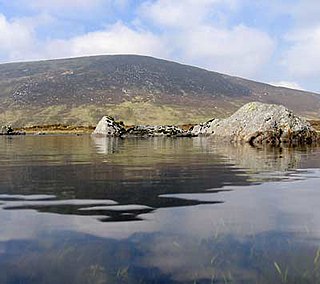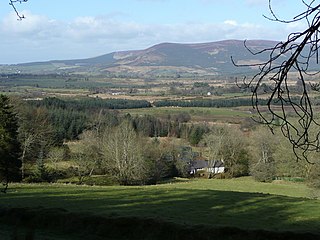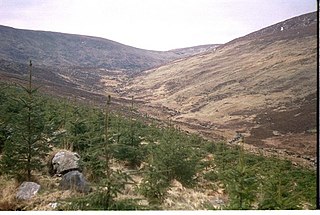
Djouce at 725 metres (2,379 ft), is the 74th–highest peak in Ireland on the Arderin scale, and the 91st–highest peak on the Vandeleur-Lynam scale. Djouce is situated in the northeastern section of the Wicklow Mountains, and dominates the views of the Wicklow Mountains from Roundwood to Newtownmountkennedy. Djouce is one of a few Irish mountains for which the Irish Office of Public Works (OPW) maintain a boarded mountain trail, using railway sleepers, from its base to a point close to its summit; making the mountain even more accessible to the public, but while also protecting the underlying bog and soil from human erosion. Djouce is popular with hill walkers, and it lies along the 131-kilometre Wicklow Way; on its southern slopes at a scenic viewpoint is the J.B. Malone memorial stone, dedicated to the creator of the Wicklow Way.

Mullaghcleevaun at 849 metres (2,785 ft), is the 15th–highest peak in Ireland on the Arderin scale, and the 20th–highest peak on the Vandeleur-Lynam scale. Mullaghcleevaun is in the central sector of the Wicklow Mountains range, in Wicklow, Ireland; it is the 2nd highest peak in Wicklow after Lugnaquilla. Mullaghcleevaun lies on the main "central spine" of the whole range that runs from Kippure in the north, to Lugnaquillia in the south; and in particular, it lies on the continuous "central boggy ridge" that runs from the Sally Gap to Tonelagee.

Tonelagee, is at 817 metres (2,680 ft), is the 25th–highest peak in Ireland on the Arderin scale, and the 33rd–highest peak on the Vandeleur-Lynam scale. Tonelagee is situated in the central sector of the Wicklow Mountains range, and sits on the main "central spine" of the range that runs from Kippure in the north, to Lugnaquillia in the south; and in particular, the continuous "central boggy ridge" that runs from the Sally Gap in the north, via Mullaghcleevaun, to Tonelagee. Tonelagee is the third highest peak in Wicklow after Lugnaquilla and Mullaghcleevaun.

Camaderry at 699 metres (2,293 ft), is the 90th-highest peak in Ireland on the Arderin scale, and the 112th-highest peak on the Vandeleur-Lynam scale. Camaderry is situated in the southern sector of the Wicklow Mountains range, and forms a broad horseshoe around the valley of Glendalough with the hydroelectric station at Turlough Hill 681 metres (2,234 ft), and the mountains of Conavalla 734 metres (2,408 ft), and Lugduff 652 metres (2,139 ft). Camaderry has a subsidiary summit, Camaderry South East Top 677 metres (2,221 ft), and both lie across the deep Wicklow Gap from Tonelagee 817 metres (2,680 ft), which sits on the "central spine" of the Wicklow range.

Little Sugar Loaf is a 342 metres (1,122 ft) hill in the far northeastern sector of the Wicklow Mountains in Ireland. It does not have the elevation to rank on Arderin, Hewitt, or Vandeleur-Lynam scales, however, its prominence of 247 metres (810 ft) ranks it as a Marilyn.

Maulin, at 570 metres (1,870 ft), is the 272nd–highest peak in Ireland on the Arderin scale, however, being below 600 m it does not rank on the Vandeleur-Lynam or Hewitt scales. Maulin is in the far northeastern section of the Wicklow Mountains, at the mouth of Glensoulan Valley; Powerscourt Waterfall lies at its base.

Cloghernagh at 800 metres (2,600 ft), does not have the prominence to qualify as an Arderin, but does have the prominence to be the 40th–highest peak on the Vandeleur-Lynam scale. Cloghernagh is situated in the southern sector of the Wicklow Mountains range, and is part of the large massif of Lugnaquilla 925 metres (3,035 ft), Wicklow's highest mountain.

Slievemaan at 759 metres (2,490 ft), is the 54th–highest peak in Ireland on the Arderin scale, and the 70th–highest peak on the Vandeleur-Lynam scale. Slievemaan is situated in the southwen sector of the Wicklow Mountains range, and is part of the large massif of Lugnaquilla 925 metres (3,035 ft), Wicklow's highest mountain. Slievemaan lies at the southern end of the Glen of Imaal.

Conavalla at 734 metres (2,408 ft), is the 69th–highest peak in Ireland on the Arderin scale, and the 85th–highest peak on the Vandeleur-Lynam scale. The summit of Conavalla sits just off the main "central spine" of the Wicklow mountains range in Ireland, as it runs from Kippure in the north, to Lugnaquillia in the south. Conavalla's large massif to the north-east is described as a "wet and boggy barren plain" whose various shoulders dominate the head of the Glendalough valley, and the upper east-side of the Glenmalure valley.

Table Mountain is a 702-metre (2,303 ft) peak in the southern section of the Wicklow Mountains range in Ireland. With a prominence of only 16 metres (52 ft), it is only listed in a few of the recognised categories of mountains in Ireland; it is the 110th–highest peak on the Vandeleur-Lynam Irish scale. Table Mountain is at the apex of a horseshoe-shaped "boggy" massif with its larger neighbours, Camenabologue 758 metres (2,487 ft) and Conavalla 734 metres (2,408 ft) that sit at the head of the Glenmalure valley; all three peaks lie close to the "central spine" of the range as it runs from Kippure in the north, to Lugnaquillia in the south. There is no recorded Irish language name for Table Mountain, and it has no connection with Table Mountain in Cape Town, South Africa.

Lobawn at 636 metres (2,087 ft), is the 182nd–highest peak in Ireland on the Arderin scale, and the 219th–highest peak on the Vandeleur-Lynam scale. Lobawn has a flat boggy summit plateau with a "war department" concrete post to mark the top. Lobawn lies in the west section of the Wicklow Mountains, in Wicklow, Ireland, and has a subsidiary summit called Sugarloaf 552 metres (1,811 ft). Both Lobawn and the Sugarloaf border the Glen of Imaal, and their summits lie close to the actual boundaries of the Glen of Imaal Military Artillery Firing Range.

Corrigasleggaun at 794 metres (2,605 ft), is the 35th–highest peak in Ireland on the Arderin scale, and the 45th–highest peak on the Vandeleur-Lynam scale. Corrigasleggaun is situated in the southwestern sector of the Wicklow Mountains range, and is part of the large massif of Lugnaquilla 925 metres (3,035 ft), Wicklow's highest mountain. Corrigasleggaun lies at the head of the glen of the easterly flowing Carrawaystick River, which includes the scenic corrie lake of Kelly's Lough near its summit, and Carrawaystick Mountain at its base. Corrigasleggaun also lies alongside Lugnaquilla's South Prison, from which the River Ow flows south to the Aghavannagh Bridge.

Gravale at 718 metres (2,356 ft), is the 79th–highest peak in Ireland on the Arderin scale, and the 98th–highest peak on the Vandeleur-Lynam scale. Gravale is in the middle sector of the Wicklow Mountains range, in Wicklow, Ireland. Gravale sits on a north-east to south-west "boggy ridge" that forms the "central spine" of the whole range, which runs from the Sally Gap, to Carrigvore 682 metres (2,238 ft), to Gravale, and after a col to Duff Hill 720 metres (2,360 ft), which is part of the larger massif of Mullaghcleevaun 849 metres (2,785 ft).

Moanbane at 703 metres (2,306 ft), is the 85th–highest peak in Ireland on the Arderin scale, and the 106th–highest peak on the Vandeleur-Lynam scale. Moanbane is in the central sector, at the western edge, of the Wicklow Mountains, in Wicklow, Ireland. Moanbane is on a small massif alongside Silsean 698 metres (2,290 ft) which lies between the Blessington lakes, and the taller mountain of Mullaghcleevaun 849 metres (2,785 ft).

Silsean at 698 metres (2,290 ft), is the 92nd–highest peak in Ireland on the Arderin scale, and the 114th–highest peak on the Vandeleur-Lynam scale. Silsean is in the central sector, at the western edge, of the Wicklow Mountains, in Wicklow, Ireland. Silsean is on a small massif alongside Moanbane 703 metres (2,306 ft) which lies between the Blessington lakes, and the major massif of Mullaghcleevaun 849 metres (2,785 ft).

Benleagh at 689 metres (2,260 ft), does not have the prominence to qualify as an Arderin, but its prominence does allow it to rank as the 125th–highest peak on the Vandeleur-Lynam scale. Benlagh is situated in the southern sector of the Wicklow Mountains, and is part of the large massif of Lugnaquilla 925 metres (3,035 ft), Wicklow's highest mountain.

War Hill at 686 metres (2,251 ft), is the 106th–highest peak in Ireland on the Arderin scale, and the 129th–highest peak on the Vandeleur-Lynam scale. War Hill is in the far northeastern section of the Wicklow Mountains, in Wicklow, Ireland. Due to its remote setting, it is usually only accessed as part of a larger hill-walking route taking in other neighbouring peaks such as Djouce or Maulin. One of the few distinguishing landmarks in the area is the Coffin Stone that lies in the saddle between War Hill and Djouce, whose origin is uncertain.

Tonduff at 642 metres (2,106 ft), is the 169th–highest peak in Ireland on the Arderin scale, and the 202nd–highest peak on the Vandeleur-Lynam scale. Tonduff is in the far northeastern section of the Wicklow Mountains, in Wicklow, Ireland. The main flat summit is sometimes listed as Tonduff North, while the subsidiary summit, Tonduff East Top 593 metres (1,946 ft), is sometimes listed as Tonduff South. Tonduff East Top has a prominence of only 15 metres (49 ft), which just qualifies it as an Arderin Beg. A bog on the western slopes of Tonduff, the Liffey Head Bog, forms the source of the River Liffey; bogs on the southern slopes of Tonduff, forms the source of the River Dargle.

Scarr Mountain at 641 metres (2,103 ft), is the 174th–highest peak in Ireland on the Arderin scale, and the 207th–highest peak on the Vandeleur-Lynam scale. Scarr is situated in the central sector of the Wicklow Mountains range, but off main "central spine" of the range that runs from Kippure in the north, to Lugnaquillia in the south. Scarr lies on its own small massif that includes Scarr North-West Top 561 metres (1,841 ft) and Kanturk 523 metres (1,716 ft); it is bounded by Lough Dan to the east and the Glenmacnass Valley on the west. Scarr's sharp peak gives it a distinctive profile amongst the rounded summits of the Wicklow mountains, and it forms the backdrop to scenic views across the Guinness Estate and Lough Dan.

Prince William's Seat at 555 metres (1,821 ft), is the 296th–highest peak in Ireland on the Arderin scale, however, it does not have the elevation to quality as a Vandeleur-Lynam. Prince William's Seat is on the border of the Wicklow Mountains and Dublin Mountains in Ireland, and lies on the northern side of the Glencree valley, positioned at its entrance. Prince William's Seat is separated by a small col from neighbouring Knocknagun, which is also 555 metres (1,821 ft) in height. Prince William's Seat and Knocknagun are popular peaks with hill-walkers.































